It is common for modern man to throw away things that have lost their presentation. Even if a single speck or a small lead appeared on the clothes, it often goes to the trash can.
The culture of consumption has played its role in this: marketers and advertisers inspire us that the wardrobe needs to be constantly updated, and not to wear things longer than one or two seasons.
But is it really necessary to get rid of good clothes that can last a few more seasons, if the defect can be eliminated on its own? After all, many of us have already forgotten that torn clothes can be darned and patched: this will save the family and budget and not clutter the wardrobe with an abundance of things.
In today's article we will tell you about how you can bring torn jeans into proper form with patches. You will learn some simple and effective ways to repair trousers that even an aspiring needlewoman can handle.
We remove the holes
The technology for performing the patches will vary somewhat, depending on where the jeans are torn. Pants are usually torn in places that are subject to friction or stretching.
Most often it is the knees and the area between the legs. If in the first case the patch is noticeable, even if it is done very carefully, then a patch can be sewn between the legs so that no one will guess about its presence.
Sew the patch best on a sewing machine - so you can do the job as well as possible. At the same time, the model of the unit is absolutely not important - be it an old mechanical machine, inherited from your grandmother or a modern computer-controlled device.
In addition to the sewing machine, you will need:
- matching denim piece;
- thread to match;
- scissors;
- set of safety pins.
Between the legs
Before you begin the main work, you need to give the hole a neater look.
To do this, cut from its edges sticking long threads. Then the edges of the gap need to be swept between each other so that it does not continue to grow in size. Do it manually. Stitches should be fairly frequent, but wide.
Sew not tight: in place of the hole should not remain wrinkles of fabric or hard, protruding seam. The torn site needs to be made as smooth and even as possible.
Next you need to cut a patch of a suitable shape and size. It should be a little more than the rip itself. We will sew the patch on the back of the jeans so that it is less noticeable.
It is preliminary recommended to fix the patch in place with the help of pins - so you do not have to constantly make sure that it does not shift in the process.
Now turn on the sewing machine, fill the thread and proceed to the thing (this is the name of the patch sewing process). Select a zigzag mode and lay lines across the entire surface of the patch.
It is necessary to try to make lines as close as possible to each other. The most convenient way is to use the reverse function; if you don’t have one on your unit, you’ll have to start the line from the beginning each time.
Upon completion, fix and cut the thread.
On the knee
In the knee area, jeans are most often torn by children who do not sit still for a minute.Buying new trousers every time a similar nuisance occurs would be a waste, because a damaged item can be easily and quickly repaired with your own hands.
The patch on the knee, even if it is made with great skill, on closer inspection will almost certainly be noticeable. Therefore, we offer you a way to repair jeans, in which the patch becomes a stylish design element.
To do this, you need a piece of denim in a contrasting shade. For example, bright blue denim patches will look spectacular on black jeans. You can cut a suitable piece of the old denim thing, which you will definitely not wear.
- So, the first thing to do is to decide on the size of the patch and cut a suitable fragment.
- The patch should be about the width of the leg, and long enough - about 15 cm. If it is difficult for you to cut out the detail from the first time, make a paper pattern. Do not forget to make a small hemming allowance - about 0.5 cm.
- Fold the patch around the edges and sweep.
- Now you can sew it to the leg. The most convenient way to do this is on a sewing machine, but you can do it manually.
- This method assumes the presence of such inserts on two legs - so the result looks more complete and aesthetic. Therefore, do the same on the other leg.
If you have a large piece of leather, it can also be used as a patch on the knees.
What material can be used for the patch?
There is not always a suitable piece of denim at home, and spending time buying a few centimeters of denim in a sewing shop is not at all practical.
However, experienced needlewomen came up with several possible ways out of the situation. Consider the most interesting of them.
Use the "native" fabric
The easiest way to find a suitable fabric in color and texture is to cut a piece of the very jeans that need repair. But you need to choose a place in which the absence of a piece of material will not be noticeable.
The only such piece of jeans is under the back pockets. From here you can borrow some material without sacrificing the overall look of the product.
Instead of the cut fragment, you can sew any other fabric, because the inside of the pockets is invisible to others. The main thing is to choose a sufficiently dense material and firmly zashtukovat jeans from the wrong side.
We use glue
Glue fabric, which is also called “cobweb”, can be put into action only when we are dealing not with through holes, but with strong scuffs, which are about to turn into tears.
- Plot of jeans, which must be strengthened with adhesive material, must first be well steamed and ironed.
- Then a small piece of cobweb is glued with the help of the same iron.
- It is recommended to fix the result by stitching a worn place on a sewing machine with a zigzag stitch.
- Threads should be chosen to match the main material of the product.
How to sew decorative patches?
As we said above, the patch can perform not only a practical function: it can also be part of a design that gives things individuality. This is especially true for children's things that should be beautiful and original.
There are many ways to create unusual patches using different materials. Here are some of the most interesting and colorful solutions:
- turn holes on your knees into funny monsters;
- make a cute appliqué on a torn place;
- to repair the tear using patchwork technique elements;
- sew a lot of small patches instead of one big one;
- camouflage small holes with embroidery.
Thermo patches
Perhaps the most elementary way to eliminate a hole in jeans is to close it with a thermal patch.
Thermo patches, or thermo glues are textile pictures on a glue base. They can be made in the form of animals, cartoon characters, machines, various inscriptions and logos.
The thermo patch is glued very simply - you just need to attach it to the torn place and walk on it with a hot iron. If you are afraid that the edges of the hole under such a patch may disperse, first strengthen them with glue.
Lace patches
Another original method of playing with holes on jeans is to decorate them with lace fabric inserts. The combination of rough jeans and fine lace looks incredibly impressive.
For this purpose, you can choose guipure of any shade, but patches of white lace look best if the jeans are dark, or of black if they are light.
Sew on lace inserts should be the same as regular patches - from the wrong side of the pants. Only sweep the edges of the hole is not necessary. You can even slightly break it to the desired size and make at the edges of a careless fringe.








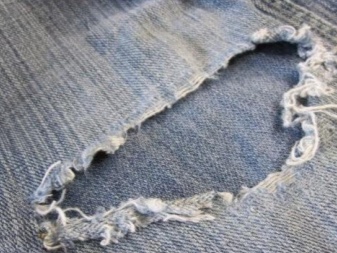
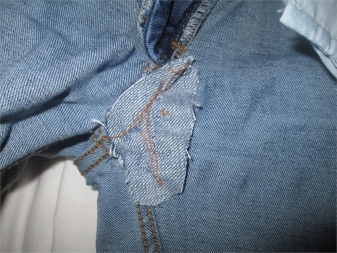
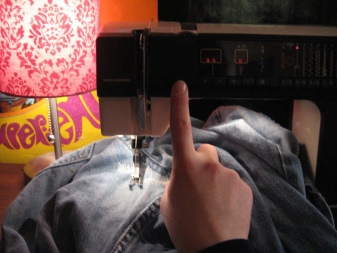
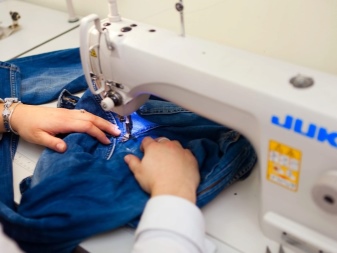
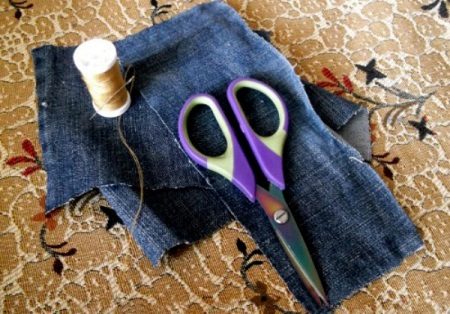
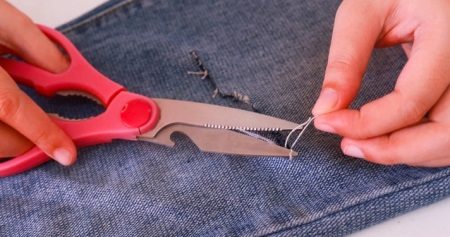
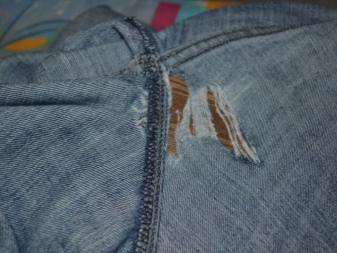
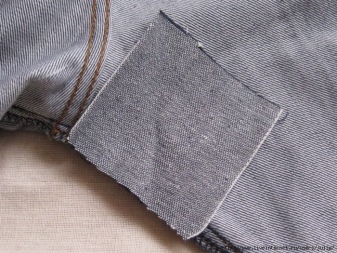
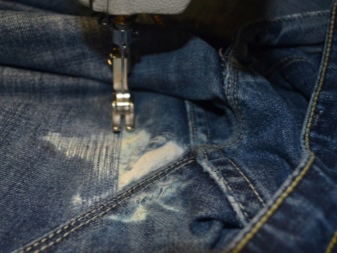
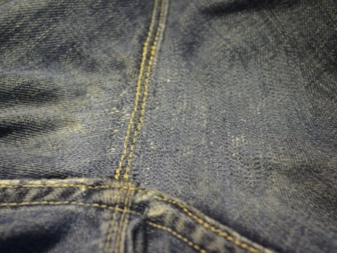



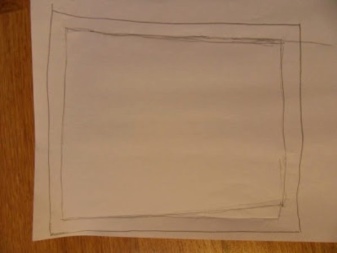

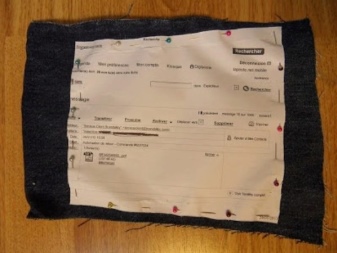
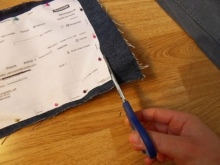

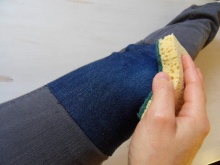
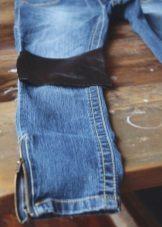
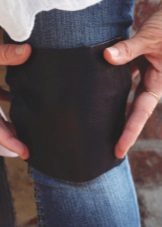
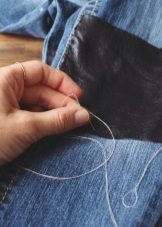

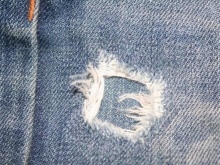
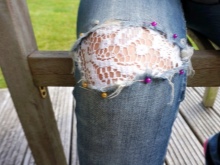



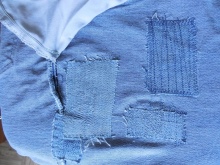

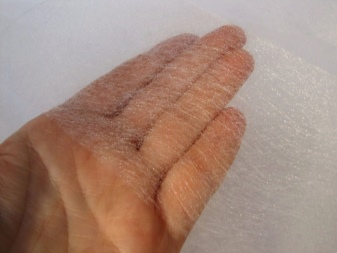
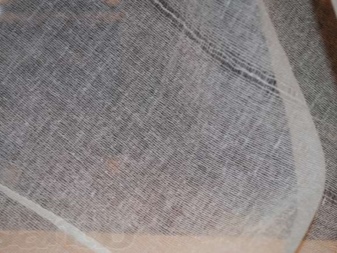
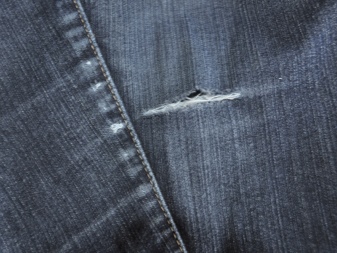
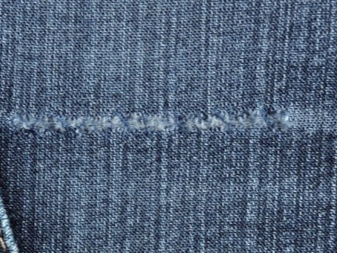


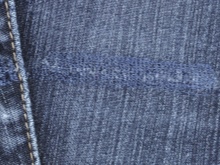


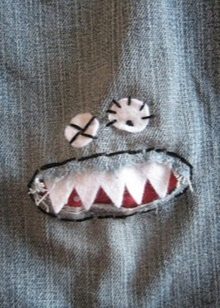

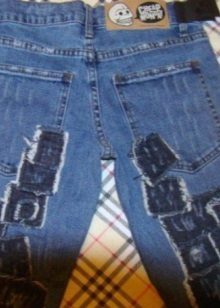








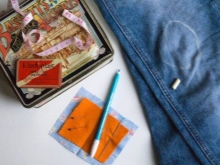
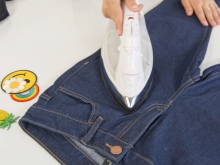
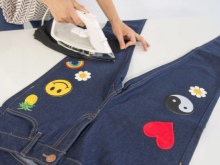

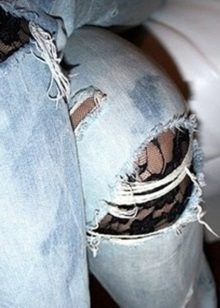

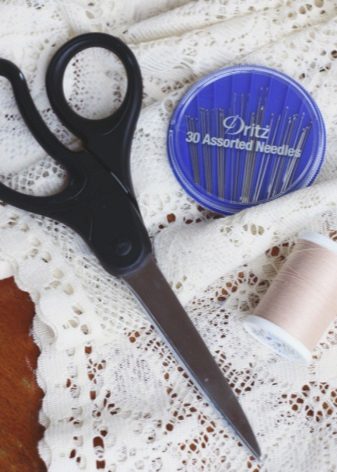
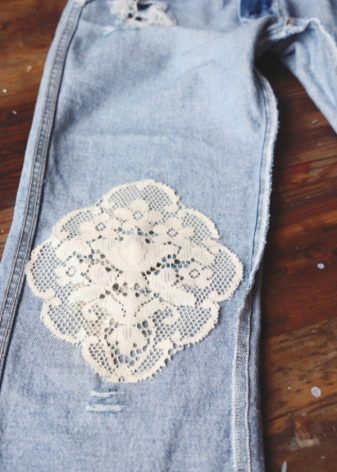
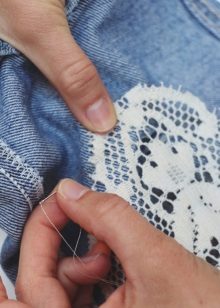













Thank! It turned out to patch jeggins.